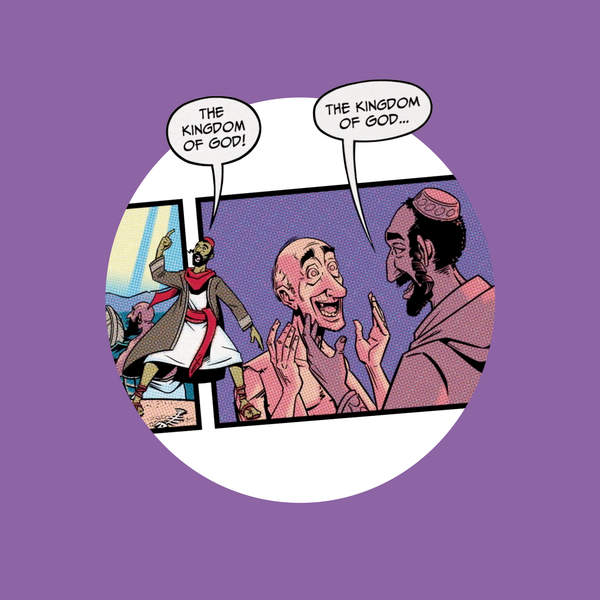
Live from Milpitas! Part 1
Episode Chapters
Show Notes
This is a special episode in our podcast series on “How To Read The Bible”. Tim and Jon went on the road to do this podcast live before an audience in Milpitas, California! Tim and Jon discuss literature design patterns in the Bible and answer questions from the audience. The guys do a brief recap of the How to Read The Bible series. There are key elements to reading the Bible well. Understanding plot, character, setting and biblical narrative style. (We have videos on each of these, you can see the links below in the show notes.) In this episode, the guys combine all of these elements to talk about “patterns and design elements” in the Bible. Tim and Jon use the “hyperlink” analogy, saying that all the stories in the Bible link to each other in subtle and creative ways. People can learn to see these links and see the stories layering on top of each other by understanding key design patterns and techniques. Below are timestamps of questions and examples: (36:16) Jon asks the question, "Is understanding design patterns in the Bible an “elite” way to read the Bible?" Isn’t the Bible supposed to be user friendly? It seems like studying to understand the historical context of the ancient Hebrew biblical literature is a time consuming task that some people might not be able to do. (40:38) A gentleman asks a question about the city of Joppa being mentioned in both the book of Jonah and in Acts. Is this intentional and a reference to a hidden theme in the Bible? (42:25) A gentleman asks a question about the creation of stories in the Bible. What’s the role of historical accuracy, retelling and condensing of events in the writing of the Bible? (49:58) A gentleman asks a question: If the Bible is a magnificent piece of timeless art and literature, How do you explain the Bible to people who value brevity and directness, not artful literature and analogy? (52:40) Tim gives an example of word plays and repetition in the Bible. The hebrew word “Tov” means good. Tov/Good is used in the creation story as a key repeating word. It develops first to describe creation. Then it describes humans (very good). Then it describes the “tree of the knowledge of good and not good/evil.” This theme culminates when the woman “sees that the tree is good” when the serpent tempts her, she has effectively switched places with God. God was the original one who “saw things as good”. (1:03:05) Tim gives another example in Luke. The baptism of Jesus culminates with God speaking from heaven declaring Jesus is his son. Then the next story is not a story, it’s a genealogy that works its way backward to Adam being declared “the son of God”. Then Jesus is tempted, with the devil asking him if he “really is the son of God”. Then Jesus goes to his first town and people ask “Who’s son is this?” Then Jesus casts out a demon who declares that Jesus is “the son of God”. Luke uses repetition to make a point to the reader, that Jesus is indeed who he has been declared to be, he is the Son of God. (1:07:10) Tim gives an example of the selection of Saul to be the king of Israel. The hidden word in the story is “see or seeing.” At the start of the story, we are told Saul is tall. This is a strange detail. Most Bible characters have no physical attributes described about them, but here, Saul is tall, which is later used as a symbol in the story. Saul looks for a “seer” or a “prophet” when searching for his father’s donkeys. Why would the word “seer” be used in the story? Because it is a hidden key word in the story. Samuel “sees” Saul. Samuel tells Israel to look upon Saul and “see” their king. Samuel and Israel “see” Saul and they are impressed by his height. But Saul is not a good king and God rejects him. God sends Samuel to anoint a new king. God says he has “seen a new king.” Samuel “sees” Jesse’s son Eliab and thinks one of these is to be the new king. But God speaks to Samuel and says “God doesn’t ‘see’ as humans ‘see’, humans ‘see’ with their eyes, God ‘sees’ the heart.” This line is the climax of a whole trail of breadcrumbs that started at the introduction of Saul.
Produced By:
Dan Gummel, Jon Collins, Matthew Halbert-Howen
Thank You To All Our Supporters!
Scripture References
Referenced Resources
- "The Art Of Biblical Narrative" by Robert Alter
- Our How To Read The Bible Video Series: https://www.youtube.com/watch?v=ak06MSETeo4&list=PLH0Szn1yYNedn4FbBMMtOlGN-BPLQ54IH
Interested in learning more? Check out Tim's library for a list of recommended books and other resources.
Get the BibleProject app for access to our entire library of resources in one place.